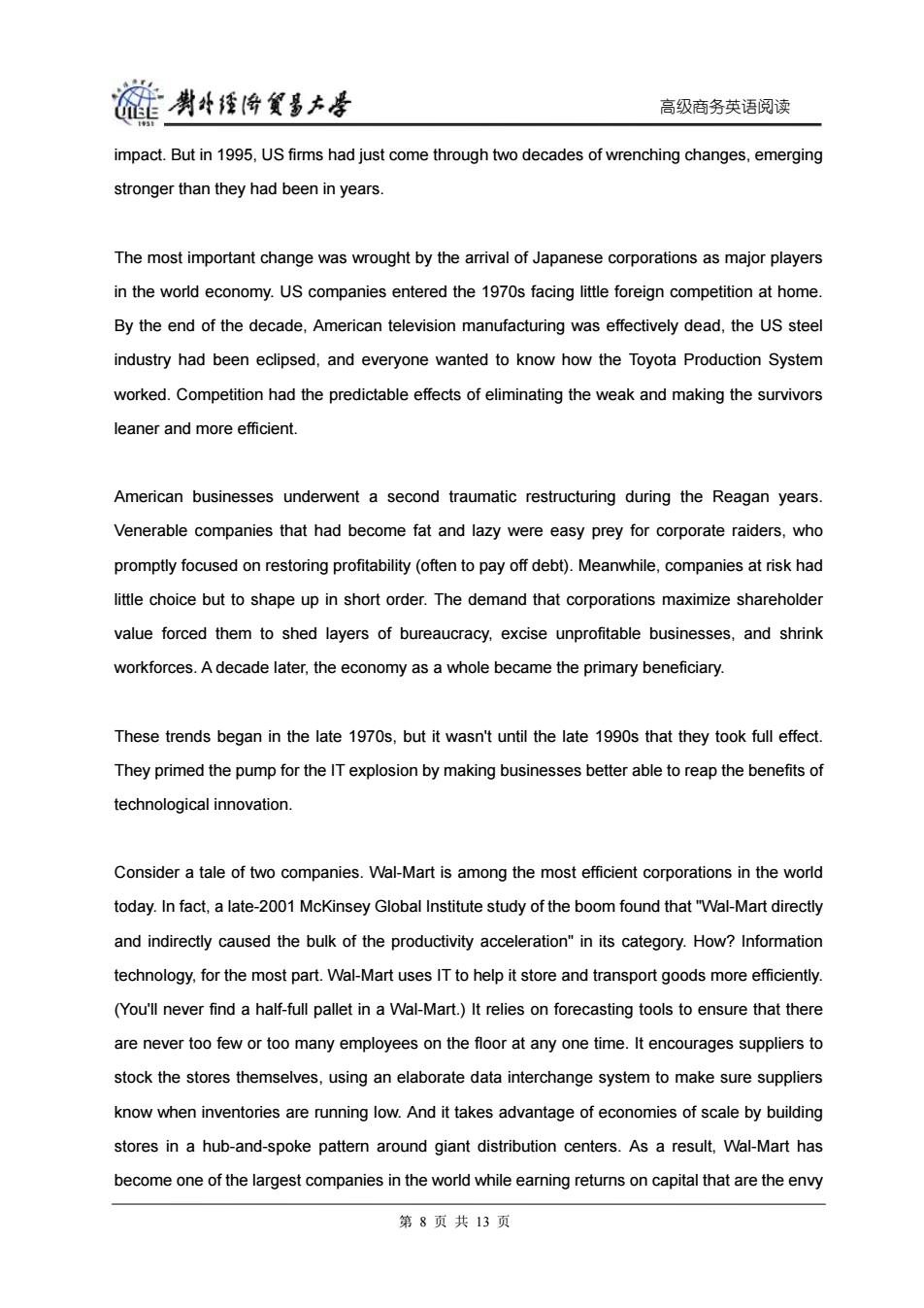正在加载图片...

剥牛煙将多大是 高级商务英语阅读 impact.But in 1995,US firms had just come through two decades of wrenching changes,emerging stronger than they had been in years. The most important change was wrought by the arrival of Japanese corporations as major players in the world economy.US companies entered the 1970s facing little foreign competition at home. By the end of the decade,American television manufacturing was effectively dead,the US steel industry had been eclipsed,and everyone wanted to know how the Toyota Production System worked.Competition had the predictable effects of eliminating the weak and making the survivors leaner and more efficient. American businesses underwent a second traumatic restructuring during the Reagan years. Venerable companies that had become fat and lazy were easy prey for corporate raiders,who promptly focused on restoring profitability(often to pay off debt).Meanwhile,companies at risk had little choice but to shape up in short order.The demand that corporations maximize shareholder value forced them to shed layers of bureaucracy,excise unprofitable businesses,and shrink workforces.A decade later,the economy as a whole became the primary beneficiary. These trends began in the late 1970s.but it wasn't until the late 1990s that they took full effect. They primed the pump for the IT explosion by making businesses better able to reap the benefits of technological innovation. Consider a tale of two companies.Wal-Mart is among the most efficient corporations in the world today.In fact,a late-2001 McKinsey Global Institute study of the boom found that"Wal-Mart directly and indirectly caused the bulk of the productivity acceleration"in its category.How?Information technology,for the most part.Wal-Mart uses IT to help it store and transport goods more efficiently. (You'll never find a half-full pallet in a Wal-Mart.)It relies on forecasting tools to ensure that there are never too few or too many employees on the floor at any one time.It encourages suppliers to stock the stores themselves,using an elaborate data interchange system to make sure suppliers know when inventories are running low.And it takes advantage of economies of scale by building stores in a hub-and-spoke pattern around giant distribution centers.As a result,Wal-Mart has become one of the largest companies in the world while earning returns on capital that are the envy 第8页共13页高级商务英语阅读 impact. But in 1995, US firms had just come through two decades of wrenching changes, emerging stronger than they had been in years. The most important change was wrought by the arrival of Japanese corporations as major players in the world economy. US companies entered the 1970s facing little foreign competition at home. By the end of the decade, American television manufacturing was effectively dead, the US steel industry had been eclipsed, and everyone wanted to know how the Toyota Production System worked. Competition had the predictable effects of eliminating the weak and making the survivors leaner and more efficient. American businesses underwent a second traumatic restructuring during the Reagan years. Venerable companies that had become fat and lazy were easy prey for corporate raiders, who promptly focused on restoring profitability (often to pay off debt). Meanwhile, companies at risk had little choice but to shape up in short order. The demand that corporations maximize shareholder value forced them to shed layers of bureaucracy, excise unprofitable businesses, and shrink workforces. A decade later, the economy as a whole became the primary beneficiary. These trends began in the late 1970s, but it wasn't until the late 1990s that they took full effect. They primed the pump for the IT explosion by making businesses better able to reap the benefits of technological innovation. Consider a tale of two companies. Wal-Mart is among the most efficient corporations in the world today. In fact, a late-2001 McKinsey Global Institute study of the boom found that "Wal-Mart directly and indirectly caused the bulk of the productivity acceleration" in its category. How? Information technology, for the most part. Wal-Mart uses IT to help it store and transport goods more efficiently. (You'll never find a half-full pallet in a Wal-Mart.) It relies on forecasting tools to ensure that there are never too few or too many employees on the floor at any one time. It encourages suppliers to stock the stores themselves, using an elaborate data interchange system to make sure suppliers know when inventories are running low. And it takes advantage of economies of scale by building stores in a hub-and-spoke pattern around giant distribution centers. As a result, Wal-Mart has become one of the largest companies in the world while earning returns on capital that are the envy 第 8 页 共 13 页